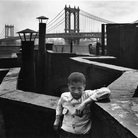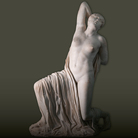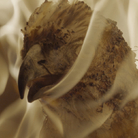Katherine Bradford. Lifeguards

Katherine Bradford, Drinks by the pool, 2021, acrylic on canvas, 152,4 x 182,8 cm.
Dal 1 July 2021 al 9 October 2021
Milano
Luogo: kaufmann repetto
Indirizzo: Via di Porta Tenaglia 7
Telefono per informazioni: +39 02 72094331
E-Mail info: info@kaufmannrepetto.com
Sito ufficiale: http://kaufmannrepetto.com
kaufmann repetto è lieta di presentare Lifeguards, la prima personale di Katherine Bradford con la galleria.
Ipnotico e al contempo rigoroso, il linguaggio visivo di Katherine Bradford si muove liberamente attraverso il confine fra pittura non oggettiva e figurativa, consentendo lo sviluppo di narrazioni potenziali che si intrecciano all’indagine di forma e colore.
Nella mostra Lifeguards ci troviamo immersi in un mondo composto da ampie campiture di colore che rappresentano cielo e distese d’acqua, popolati da bagnanti e nuotatori. Sfumature di blu che spaziano dal cobalto all’azzurro, e dall’oltremare al turchese, suddividono la tela in piani orizzontali ben definiti, mentre le variazioni di saturazione e tono evocano un’atmosfera sfuggente e insieme tangibile. Le tonalità più chiare e più scure sono intercambiabili, e utilizzate senza una distinzione funzionale o gerarchica. Delicate modulazioni del lavanda chiaro e del viola intenso rappresentano le spiagge, e riaffiorano in altre opere per raffigurare parti del corpo. Un firmamento color indaco si fonde in uno specchio d’acqua zaffiro, altrettanto saturato, come se i due elementi si compenetrassero di comune accordo. La strategia compositiva è variegata: alcuni dipinti si limitano a due campiture dominanti, in altri la presenza di strisce rosse, bianche o gialle introducono ulteriori elementi spaziali come il fondale marino o il bordo di una piscina. Questi sfondi quasi monocromatici sono occupati da numerosi nuotatori sospesi in aria o intenti a tuffarsi, mentre altri sono riuniti a riva. I loro corpi androgini e privi di lineamenti sono abbozzati con colori audaci che ne rappresentano la pelle abbronzata, tinta di rosa pallido o intenso, di salmone o viola acceso. Spesso assumono posizioni fantastiche e assurde, effetto amplificato dalle manipolazioni imprevedibili della prospettiva pittorica. Nella metà superiore della tela incontriamo due nuotatori che fluttuano maestosi sopra distese orizzontali di azzurro slavato; altri sono bloccati nel momento del tuffo, di testa, e immortalati in angolazioni bizzarre. In contrasto con tali pose stravaganti, quasi buffe, i bagnini che danno il titolo alla mostra sono seduti o in piedi accanto alle torrette, la cui verticalità tridimensionale spezza le composizioni predominanti, fatte di immagini piatte. Due bagnini sono impegnati in misure di salvataggio: l’uomo tira fuori dall’acqua un nuotatore, afferrandolo con forza dalle gambe, mentre la donna stringe fra le braccia il corpo di una persona appena soccorsa, una silhouette immobile dall’innaturale pallore bluastro. In questi gruppi di figure sono evidenti i rimandi alla storia dell’arte, che evocano soggetti biblici come Giovanni Battista e la Pietà. La natura duplice del titolo della mostra, “life” (“vita”) e “guard” (“guardia”, “guardiano”), inoltre, emerge in modo letterale in questi quadri, che alludono al compito del bagnino che sorveglia altri esseri umani o al suo ruolo di “salvatore”.
Se l’oscillazione fra elementi astratti e figurativi cattura e intrappola lo spettatore, offrendogli diverse interpretazioni, è anche una chiave per comprendere la portata più ampia della ricerca artistica di Bradford. L’artista, che nella prima fase della sua carriera si è concentrata sulla pittura astratta, da vent’anni ha aperto la propria pratica alla figurazione, senza però dimenticare il profondo interesse per [la natura più astratta dei] campi di colore. Il suo amore per il pittorico emerge con chiarezza; tuttavia Bradford, guidata da una curiosità imparziale, lascia che il suo immaginario acquisisca una malleabilità porosa in cui un segno pittorico diventa un significante. Le prime tracce, dipinte bruscamente, che si sono manifestate come oggetti nell’universo del colore erano navi, pianeti e ufo. Esseri umani che fluttuavano in posizione orizzontale, sotto forma di supereroi e nuotatori che sfidavano la gravità, sono comparsi sulla scena poco dopo: sospesi sulle profondità insondabili di oceani e cieli stellati, questi personaggi peculiari sembrano dividersi tra una libertà assoluta e un solipsismo malinconico. Negli ultimi due o tre anni, il peso della difficile situazione politica e, più di recente, l’impatto della pandemia causata dal Covid hanno spinto l’artista ad approfondire tematiche legate ai rapporti sociali fra esseri umani, interesse che riflette inoltre il suo impegno di lunga data verso le comunità artistiche a New York e nel Maine. L’indagine di gruppi di figure più complessi è al centro delle sue opere più recenti, esposte nella mostra Mother alla Canada Gallery di New York e nell’attuale mostra Lifeguards a Milano. “Raffiguro persone, ma in realtà sottolineo un aspetto universale” dice l’artista. “Sento che è importante esplorare chi siamo, come ci adattiamo, come ci adattiamo insieme a livello visivo, come stiamo gli uni accanto agli altri.”
Bradford, per buona parte della sua carriera indifferente ai vincoli formali della produzione culturale, ha affinato la propria pratica per oltre quarant’anni, maturando fino a raggiungere una libertà non accademica e creativa che rispecchia appieno le riflessioni estetiche e sociopolitiche dell’epoca in cui viviamo. La sua posizione sembra incarnare la “modernità liquida” teorizzata dal sociologo Zygmunt Bauman, secondo cui, dopo la dissoluzione degli assiomi “solidi” del modernismo (come la razionalità e la ricerca della perfezione), siamo giunti a una modernità più “leggera” e “liquida”, in cui “il cambiamento è l’unica cosa permanente, e l’incertezza è l’unica certezza”. È la dedizione al cambiamento dinamico e allo stato fluido dell’unione fra gli uomini che Bradford – con una strizzatina d’occhio e una buona dose di umorismo – esprime in modo tanto toccante nei suoi campi liquidi e raggianti.
Katherine Bradford (New York, 1942) vive e lavora a New York. Ha iniziato a dipingere a trent’anni, quando viveva nel Maine, e negli anni Ottanta si è trasferita a Williamsburg, Brooklyn, con un gruppo di artisti. Le sue opere sono state esposte in tutto il mondo, al Tang Teaching Museum, Skidmore College, New York (2020); Crystal Bridges Museum of American Art, Bentonville (2019); Brooklyn Museum, New York; Modern Art Museum in Fort Worth, Texas (2017); MoMA P.S. 1 (2007) e all’Ogden Museum in Prospect.4: the New Orleans Biennial. I suoi quadri fanno parte di varie collezioni, tra cui quelle del Metropolitan Museum of Art, Brooklyn Museum, Dallas Museum of Art, della Menil Collection di Houston, del Nerman Museum of Contemporary Art di Overland Park e del Portland Museum of Art. Bradford ha ricevuto una Guggenheim Fellowship e un Joan Mitchell Grant. Ha insegnato in istituzioni come la Yale School of Art, Skowhegan School of Painting and Sculpture e Pennsylvania Academy of the Fine Arts, Philadelphia. Nel 2022, le sarà dedicata un’antologica itinerante organizzata dal Portland Museum of Art, Maine.
Ipnotico e al contempo rigoroso, il linguaggio visivo di Katherine Bradford si muove liberamente attraverso il confine fra pittura non oggettiva e figurativa, consentendo lo sviluppo di narrazioni potenziali che si intrecciano all’indagine di forma e colore.
Nella mostra Lifeguards ci troviamo immersi in un mondo composto da ampie campiture di colore che rappresentano cielo e distese d’acqua, popolati da bagnanti e nuotatori. Sfumature di blu che spaziano dal cobalto all’azzurro, e dall’oltremare al turchese, suddividono la tela in piani orizzontali ben definiti, mentre le variazioni di saturazione e tono evocano un’atmosfera sfuggente e insieme tangibile. Le tonalità più chiare e più scure sono intercambiabili, e utilizzate senza una distinzione funzionale o gerarchica. Delicate modulazioni del lavanda chiaro e del viola intenso rappresentano le spiagge, e riaffiorano in altre opere per raffigurare parti del corpo. Un firmamento color indaco si fonde in uno specchio d’acqua zaffiro, altrettanto saturato, come se i due elementi si compenetrassero di comune accordo. La strategia compositiva è variegata: alcuni dipinti si limitano a due campiture dominanti, in altri la presenza di strisce rosse, bianche o gialle introducono ulteriori elementi spaziali come il fondale marino o il bordo di una piscina. Questi sfondi quasi monocromatici sono occupati da numerosi nuotatori sospesi in aria o intenti a tuffarsi, mentre altri sono riuniti a riva. I loro corpi androgini e privi di lineamenti sono abbozzati con colori audaci che ne rappresentano la pelle abbronzata, tinta di rosa pallido o intenso, di salmone o viola acceso. Spesso assumono posizioni fantastiche e assurde, effetto amplificato dalle manipolazioni imprevedibili della prospettiva pittorica. Nella metà superiore della tela incontriamo due nuotatori che fluttuano maestosi sopra distese orizzontali di azzurro slavato; altri sono bloccati nel momento del tuffo, di testa, e immortalati in angolazioni bizzarre. In contrasto con tali pose stravaganti, quasi buffe, i bagnini che danno il titolo alla mostra sono seduti o in piedi accanto alle torrette, la cui verticalità tridimensionale spezza le composizioni predominanti, fatte di immagini piatte. Due bagnini sono impegnati in misure di salvataggio: l’uomo tira fuori dall’acqua un nuotatore, afferrandolo con forza dalle gambe, mentre la donna stringe fra le braccia il corpo di una persona appena soccorsa, una silhouette immobile dall’innaturale pallore bluastro. In questi gruppi di figure sono evidenti i rimandi alla storia dell’arte, che evocano soggetti biblici come Giovanni Battista e la Pietà. La natura duplice del titolo della mostra, “life” (“vita”) e “guard” (“guardia”, “guardiano”), inoltre, emerge in modo letterale in questi quadri, che alludono al compito del bagnino che sorveglia altri esseri umani o al suo ruolo di “salvatore”.
Se l’oscillazione fra elementi astratti e figurativi cattura e intrappola lo spettatore, offrendogli diverse interpretazioni, è anche una chiave per comprendere la portata più ampia della ricerca artistica di Bradford. L’artista, che nella prima fase della sua carriera si è concentrata sulla pittura astratta, da vent’anni ha aperto la propria pratica alla figurazione, senza però dimenticare il profondo interesse per [la natura più astratta dei] campi di colore. Il suo amore per il pittorico emerge con chiarezza; tuttavia Bradford, guidata da una curiosità imparziale, lascia che il suo immaginario acquisisca una malleabilità porosa in cui un segno pittorico diventa un significante. Le prime tracce, dipinte bruscamente, che si sono manifestate come oggetti nell’universo del colore erano navi, pianeti e ufo. Esseri umani che fluttuavano in posizione orizzontale, sotto forma di supereroi e nuotatori che sfidavano la gravità, sono comparsi sulla scena poco dopo: sospesi sulle profondità insondabili di oceani e cieli stellati, questi personaggi peculiari sembrano dividersi tra una libertà assoluta e un solipsismo malinconico. Negli ultimi due o tre anni, il peso della difficile situazione politica e, più di recente, l’impatto della pandemia causata dal Covid hanno spinto l’artista ad approfondire tematiche legate ai rapporti sociali fra esseri umani, interesse che riflette inoltre il suo impegno di lunga data verso le comunità artistiche a New York e nel Maine. L’indagine di gruppi di figure più complessi è al centro delle sue opere più recenti, esposte nella mostra Mother alla Canada Gallery di New York e nell’attuale mostra Lifeguards a Milano. “Raffiguro persone, ma in realtà sottolineo un aspetto universale” dice l’artista. “Sento che è importante esplorare chi siamo, come ci adattiamo, come ci adattiamo insieme a livello visivo, come stiamo gli uni accanto agli altri.”
Bradford, per buona parte della sua carriera indifferente ai vincoli formali della produzione culturale, ha affinato la propria pratica per oltre quarant’anni, maturando fino a raggiungere una libertà non accademica e creativa che rispecchia appieno le riflessioni estetiche e sociopolitiche dell’epoca in cui viviamo. La sua posizione sembra incarnare la “modernità liquida” teorizzata dal sociologo Zygmunt Bauman, secondo cui, dopo la dissoluzione degli assiomi “solidi” del modernismo (come la razionalità e la ricerca della perfezione), siamo giunti a una modernità più “leggera” e “liquida”, in cui “il cambiamento è l’unica cosa permanente, e l’incertezza è l’unica certezza”. È la dedizione al cambiamento dinamico e allo stato fluido dell’unione fra gli uomini che Bradford – con una strizzatina d’occhio e una buona dose di umorismo – esprime in modo tanto toccante nei suoi campi liquidi e raggianti.
Katherine Bradford (New York, 1942) vive e lavora a New York. Ha iniziato a dipingere a trent’anni, quando viveva nel Maine, e negli anni Ottanta si è trasferita a Williamsburg, Brooklyn, con un gruppo di artisti. Le sue opere sono state esposte in tutto il mondo, al Tang Teaching Museum, Skidmore College, New York (2020); Crystal Bridges Museum of American Art, Bentonville (2019); Brooklyn Museum, New York; Modern Art Museum in Fort Worth, Texas (2017); MoMA P.S. 1 (2007) e all’Ogden Museum in Prospect.4: the New Orleans Biennial. I suoi quadri fanno parte di varie collezioni, tra cui quelle del Metropolitan Museum of Art, Brooklyn Museum, Dallas Museum of Art, della Menil Collection di Houston, del Nerman Museum of Contemporary Art di Overland Park e del Portland Museum of Art. Bradford ha ricevuto una Guggenheim Fellowship e un Joan Mitchell Grant. Ha insegnato in istituzioni come la Yale School of Art, Skowhegan School of Painting and Sculpture e Pennsylvania Academy of the Fine Arts, Philadelphia. Nel 2022, le sarà dedicata un’antologica itinerante organizzata dal Portland Museum of Art, Maine.
SCARICA IL COMUNICATO IN PDF
COMMENTI

-
 Dal 2 December 2025 al 19 February 2026
Milano | Centro Culturale di Milano
Dal 2 December 2025 al 19 February 2026
Milano | Centro Culturale di Milano
Walter Rosenblum. Il mondo e la tenerezza
-
 Dal 30 November 2025 al 12 April 2026
Gallarate | Museo MA*GA
Dal 30 November 2025 al 12 April 2026
Gallarate | Museo MA*GA
Kandinsky e l’Italia
-
 Dal 29 November 2025 al 12 April 2026
Roma | Musei Capitolini
Dal 29 November 2025 al 12 April 2026
Roma | Musei Capitolini
La Grecia a Roma
-
 Dal 22 November 2025 al 3 May 2026
Torino | Sale Chiablese dei Musei Reali
Dal 22 November 2025 al 3 May 2026
Torino | Sale Chiablese dei Musei Reali
Orazio Gentileschi. Un pittore in viaggio
-
 Dal 20 November 2025 al 25 January 2026
Firenze | Palazzo Strozzi
Dal 20 November 2025 al 25 January 2026
Firenze | Palazzo Strozzi
Andro Eradze. Bones of Tomorrow
-
 Dal 21 November 2025 al 28 March 2026
Cuneo | Complesso Monumentale di San Francesco
Dal 21 November 2025 al 28 March 2026
Cuneo | Complesso Monumentale di San Francesco
La Galleria Borghese. Da Raffaello a Bernini. Storia di una collezione


